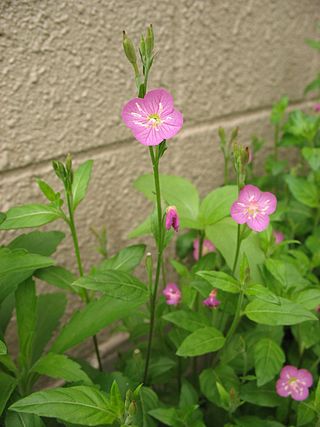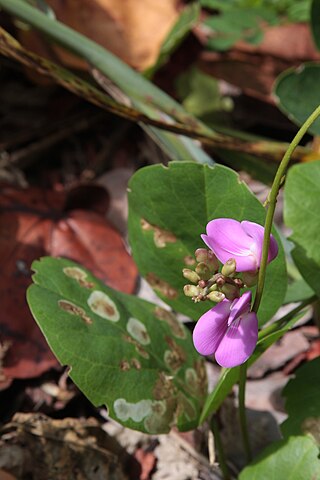
Amaryllis is the only genus in the subtribe Amaryllidinae. It is a small genus of flowering bulbs, with two species. The better known of the two, Amaryllis belladonna, is a native of the Western Cape region of South Africa, particularly the rocky southwest area between the Olifants River Valley and Knysna.

Lapageria is a genus of flowering plants with only one known species, Lapageria rosea, commonly known as Chilean bellflower or copihue. Lapageria rosea is endemic to Chile and it is the national flower of this country. It grows in forests in the southern part of Chile, being part of the Valdivian temperate rainforests ecoregion flora.

Nerine sarniensis, commonly known as Guernsey lily or Raquel is a species of flowering plant in the family Amaryllidaceae. It is the type species of the Nerine genus. It is widely cultivated in the temperate world and is particularly associated with the island of Guernsey, as reflected in both its Latin and common names, though it does not originate there, nor is it a true lily. It is native to the Northern and Western Cape Provinces of South Africa, though it is now naturalized in France, Madeira and the Azores.

Othonna is a genus of approximately 90 species of succulent or subsucculent perennial herbs or shrubs, with its center of diversity in the Greater Cape Floristic Region (GCFR) of South Africa but some species' ranges include southern Namibia, Angola, and Zimbabwe. The genus was established by Linnaeus in 1753 containing 14 species, however, of those original species, only four are still retained in Othonna, while the others have been transferred to different genera including Cineraria, Euryops, Hertia, Ligularia, Senecio, and Tephroseris. The genus Othonnna is known to be monophyletic. In 2012, a new genus Crassothonna B. Nord. was erected with 13 species transferred from Othonna. A complete modern taxonomic treatment of the genus is being undertaken by the Compton Herbarium and the South African National Biodiversity Institute. The first part, a revision of the Othonnna bulbosa group, was published in 2019.

Sarracenia rosea is a species of pitcher plant in the genus Sarracenia and is sometimes known as Burk's southern pitcher plant.

Dombeya is a flowering plant genus. Traditionally included in the family Sterculiaceae, it is included in the expanded Malvaceae in the APG and most subsequent systematics. These plants are known by a number of vernacular names which sometimes, misleadingly, allude to the superficial similarity of flowering Dombeya to pears or hydrangeas. Therefore, the genus as a whole is often simply called dombeyas. The generic name commemorates Joseph Dombey (1742–1794), a French botanist and explorer in South America, involved in the notorious "Dombey affair", embroiling scientists and governments of France, Spain, and Britain for more than two years.

Bersama abyssinica is a species of medium-sized evergreen tree in the Francoaceae family. The leaves are pinnately divided with a strongly winged rachis. The inflorescence is a spike.

Oenothera rosea, also known as rosy evening-primrose, rose evening primrose, pink evening primrose, or Rose of Mexico, is a plant belonging to the genus Oenothera and native to northern Mexico and Texas.

Euglandina is a genus of predatory medium- to large-sized, air-breathing, land snails, terrestrial pulmonate gastropod mollusks in the family Spiraxidae.

Utricularia caerulea, the blue bladderwort, is a very small to medium-sized carnivorous plant that belongs to the genus Utricularia. U. caerulea spans a wide native range, including areas in tropical Africa, Asia, and Australia. It grows as a terrestrial plant in wet, shallow soils over rock, in wet grasslands, in swamps, or near streams in open communities, mostly at lower altitudes but ascending to as much as 2,100 m (6,890 ft). It was originally described and published by Carl Linnaeus in 1753.

Canavalia rosea is a species of flowering plant of the genus Canavalia in the pea family of Fabaceae, it has a pantropical and subtropical distribution in upper beaches, cliffs, and dunes. Common names include beach bean, bay bean, sea bean, greater sea bean, seaside jack-bean, coastal jack-bean, and MacKenzie bean.

Acis is a genus of perennial, herbaceous and bulbous plants in the amaryllis family. The genus consists of nine species distributed in Europe and Northern Africa. Acis was previously included in Leucojum; both genera are known as snowflakes.
Kemulariella is a genus of flowering plants in the family Asteraceae.
Armatimonadota is a phylum of gram-negative bacteria.

Zephyranthes rosea, commonly known as the Cuban zephyrlily, rosy rain lily, rose fairy lily, rose zephyr lily or the pink rain lily, is a species of rain lily native to Peru and Colombia. They are widely cultivated as ornamentals and have become naturalized in tropical regions worldwide. Like all rain lilies, they are known for blooming only after heavy rains.
Margaretta Forten was an African-American suffragist and abolitionist.

Carex rosea, the rosy sedge, is a flowering plant and part of the family Cyperaceae. Synonyms for Carex rosea include Carex concoluta, and Carex flaccidula. It is native to central and eastern North America and it exists in wet to dry soils. Carex rosea can be found in shores of streams and bottomlands, as well as ponds. It is known to have good adaptations to dry-shade locations. It is an evergreen plant which is easy to grow.
Aitchisonia rosea is a species of flowering plant in the family Rubiaceae. It is a subshrub native to south-central Iran, Afghanistan, and Pakistan. It is the sole species in genus Aitchisonia.

Serruria rosea, the rose spiderhead, is a flower-bearing shrub that belongs to the genus Serruria and forms part of the fynbos. The plant is native to the Western Cape, South Africa.















